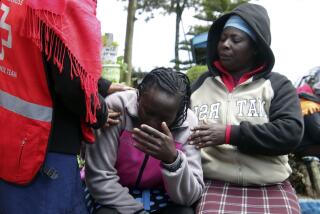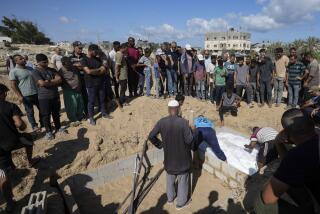Rwanda Exhumes Bodies in Bid to Regain Credibility : Africa: Government unearths 338 victims from mass graves, calls for inquiry into clashes at refugee camp.
KIGALI, Rwanda — This nation’s government scrambled to regain international respectability Thursday by inviting the world to come see and investigate the horrors of Kibeho refugee camp--but it may have done as much damage as good with a macabre on-scene exhumation of bodies from mass graves.
On a ridge line in the hills of southwestern Rwanda, among the dead, the dying and the filthy ruins of 80,000 displaced refugees, this was as strange an official event as could be imagined.
The president of Rwanda, government ministers and military leaders summoned diplomats, relief workers and journalists to the scene to argue that the Rwandan government had nothing to hide in last weekend’s bloody rampage here.
President Pasteur Bizimungu called for the United States, the United Nations, the Organization of African Unity and southern European countries to join in an international inquiry into the killings.
“The Rwandan government regrets these deaths,” he said.
He said the inquiry should convene next week to determine how many died here and how--and to investigate the army’s decision to force the closure of the camp.
So far, the army of Rwanda has taken much of the blame for the bloodshed, jeopardizing international support crucial for postwar reconstruction.
But just how bloody was the killing here? Did hundreds die or thousands? And by what instigation and at whose hand? These questions have come to absorb the Rwandan government and nations that have pledged to help rebuild this country; the call for an independent inquiry seemed to set well with international observers.
Rwandan officials were not satisfied, however, to leave the matter there. Bizimungu took the unusual step of leading the entourage down a hillside and announcing that, beginning right then, mass graves would be opened to count bodies. Workers began digging into the soft, red soil.
*
Just over four hours later, the president announced the grim toll for each of 15 grave sites. Total: 338.
Cameras, of course, recorded the gruesome piles of corpses--giving the world another shocking close-up of Rwanda’s carnage.
“What was the point of announcing the formation of a commission, and then going out and saying we’re going to un-bury the bodies and settle the matter right here? It doesn’t make any sense,” one Western diplomat remarked.
The body count was only slightly more than the 300 that Rwandan officials have said all along was a reasonable estimate of the deaths.
The United Nations had first estimated 4,000 were killed in the camp in two weekend clashes, but later the international body lowered its estimate to 2,000. Relief workers have also estimated 4,000 casualties and insisted Thursday that many more graves mar these hillsides and that the camps’ many latrines were used to dispose of bodies.
Meantime, no one has yet ventured a credible guess of what share of the dead were felled by army bullets, versus how many were killed by resisting radicals in the camp? Or how many were trampled in panic stampedes? That is, who is to blame?
The army, when it closed the camp, said it had sought to screen and separate out Hutu refugees who may have participated in last year’s slaughter of up to 1 million Tutsis.
As Rwandan soldiers tried to do this, though, armed refugees twice mounted charges against the troops, using women and children as human shields, the army says.
But some relief workers and refugee survivors accuse the Tutsi-dominated army of moving in with a heavy hand to provoke trouble, then overreacting and intentionally firing into crowds.
The United Nations said gunfire “was indiscriminate.” The relief group Doctors Without Borders said 90% of survivors it treated were shot in the back.
While at Kibeho camp, the government and diplomats unsuccessfully attempted to coax the last refugee hold-outs from a stronghold in a former school atop the ridge. Between 500 and 1,000 refugees have crammed into the filthy courtyard and defied government orders to leave. The refugees say they do not trust the government and fear being killed if they come out.
The government, and many outside observers, believe that there is a different motive: They say the tragic last stand is being staged by radicals among the refugees who fear arrest and prosecution for their roles in last year’s ethnic killings.
More to Read
Sign up for Essential California
The most important California stories and recommendations in your inbox every morning.
You may occasionally receive promotional content from the Los Angeles Times.










